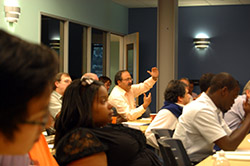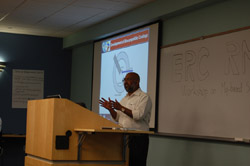NSF - Engineering Research Center (ERC)Revolutionizing Metallic Biomaterials Workshop on Mg-based Screw Projects
 Figure 1. Dr. Woo moderating Q&A after Dr. Matteo Tei's presentation on clincial requirements in Session 1. |
On July 15th and 16th, 45 ERC faculty and students from North Carolina A&T, University of Cincinnati, and University of Pittsburgh got together in Pittsburgh for the very first ERC workshop on Mg-based screw projects. The workshop was initiated by Dr. Savio Woo from the University of Pittsburgh to tackle the challenges that the Engineering System-1 (ES-1) research groups are facing in coordinating the research plans for year 4 and 5 based on the year-3 SWOT analysis. Accordingly, the main purpose of the workshop was to encourage open discussion between all participants in order to learn from each other, to coordinate the research efforts across the ES-1 as well as to make key decisions on how to move forward for year 4 and 5.
|
|
At the end of the day 1, the participants shifted gears and got together at Dr. an d Mrs. Woo’s lovely residence in Fox Chapel for some backyard volleyball and a dinner social. Dr. Sanjeev Shroff of Pitt Bioengineering also came and brought seasoned lamb chops to add some spice to the occasion. Despite having three dozen or so engineers around, setting the volleyball net proved to be difficult initially. After watching the struggle, Dr. Woo stepped in and the net was soon beautifully set up to compliment the lovely backyard. A volleyball match quickly followed and, despite the home court advantage of Dr. Woo, Dr. Kumar of NCAT showcased his serving skills to obliterate the home team with 7 straight aces. Soon after, the dinner was served with richly marinated ribs and steak thanks to Mrs. Woo. With the Pittsburgh’s famous breeze and the setting sun, the dinner could not have been served at a better time. Enjoying the view, weather, and excellent food, everyone continued their discussion from the workshop as well as lively conversations. The social lasted until 9 PM and all drag their tired bodies back to where they could get some well deserved rest and be prepared for the next day.
|
|
By 8 AM, all the workshop participants had gathered and the sessions continued. The first two sessions covered the topics in biomechanical evaluation and biocompability/toxicology assessment. In the first session, Dr. Patrick McMahon opened the second with as a moderator and provided a much needed clinical perspective to the ERC participants at the workshop. The first two sessions proved to be crucial as all the researchers agreed that standardization is essential and further efforts need to be made to standardize the testing protocols in the upcoming years. Especially in the biocompatibility and toxicology assessments, Dr. Barchowsky of Pitt suggested that a standard testing scheme based on the ISO standard should be implemented across the board in order to coordinate our efforts to commercialize the devices. Dr. Yarmolenko further suggested that simpler in vitro biomechanical testing methods should be implemented to more efficiently screen the new alloys. These suggestions will surely make our collaborations more streamlined and stronger.
|
|
In the final session of the workshop, Drs. Khanwilkar and Seoane and Mr. Lang opened the eyes of the ERC researchers to the commercialization and intellectual property management. The central mantra of this session was the systems approach, i.e. every aspect of the research toward a product has to be part of the package to commercialize. Every process along the way to the final product, design features of the screw, and accessories to facilitate the surgery should all be part of the package in order for the device to be successfully commercialized. They also covered extensively the complete steps to final commercialization including the initial funding stages and regulatory processes. Encouragingly, the three expert speakers were very enthusiastic about the future of the ERC technologies. Continuing working with Drs. Khanwilkar and Seoane as well as Mr. Lang from the McGowan Institute will be crucial for our ERC to successfully launch the commercialization of the Mg-based screw devices.
At the end of day 2, the workshop wrapped up all the discussions with a final summary by Dr. Kumta of Pitt, briefly highlighting the results and take-home messages of each session. This workshop on the ERC screw projects proved to be exactly what the ERC needed moving forward. After the exhausting preparation for the year 3 site visit, we needed to set directions on a number of unresolved issues for the upcoming years. Now we have clearly laid out clinical requirements, coordinated strategies to produce alloys and surface coating materials, and have established a common foundation on the methods to evaluate the materials for biomechanical function as well as biocompatibility and toxicity. Further, the workshop has successfully set its first stone to build the ERC’s case to commercialize the Mg-based screw devices. The outcomes of this workshop will certainly be significant for both our collaborative research efforts and for pursuing commercialization of the screw devices in the coming years.




